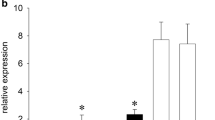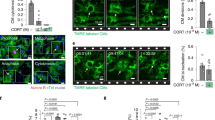Abstract
The effect of the dexamethasone (Dex) on the regulation of the T-type Ca2+ channel expressions was investigated in primary cultures of neonatal rat ventricular myocytes. We found that Dex (1 μM) increases the T-type Ca2+ current (ICaT) associated with an increase in Cav3.1 mRNA amount. We isolated the upstream region from Cav3.1 encoding gene and tested the activity of the promoter in transfected ventricular myocytes. We found a minimal Dex-responsive region that displayed putative glucocorticoid receptor (GR) and nuclear factor kappa-B (NFκB) targets. The GR selective antagonist, RU38486 (10 μM), nearly turned off the transcriptional activity of Cav3.1 encoding gene, and an NFκB inhibitor, pyrrolodine dithiocarbonate (10 μM), completely abolished the Dex-induced mRNA increase. However, Dex-induced GR and NFκB synthesis and nuclear translocation were not timely related to Cav3.1 mRNA increase. These results indicate that both GR and NFκB were necessary, but not sufficient, to trigger the increase in Cav3.1 mRNA amount. This study showed the relationship between glucocorticoid and T-type channels up-regulation that may be involved in cardiac development and pathology.







Similar content being viewed by others
References
Meaney MJ, Szyf M, Seckl JR (2007) Epigenetic mechanisms of perinatal programming of hypothalamic-pituitary-adrenal function and health. Trends Mol Med 13:269–277. doi:10.1016/j.molmed.2007.05.003
Seckl JR (1998) Physiologic programming of the fetus. Clin Perinatol 25:939–962
Jaeggi ET, Fouron JC, Silverman ED et al (2004) Transplacental fetal treatment improves the outcome of prenatally diagnosed complete atrioventricular block without structural heart disease. Circulation 110:1542–1548. doi:10.1161/01.CIR.0000142046.58632.3A
Halliday HL (2004) Use of steroids in the perinatal period. Paediatr Respir Rev 5(Suppl A):S321–S327
Edwards CR, Benediktsson R, Lindsay RS et al (1993) Dysfunction of placental glucocorticoid barrier: link between fetal environment and adult hypertension? Lancet 341:355–357. doi:10.1016/0140-6736(93)90148-A
Kamphuis PJ, de Vries WB, Bakker JM et al (2007) Reduced life expectancy in rats after neonatal dexamethasone treatment. Pediatr Res 61:72–76. doi:10.1203/01.pdr.0000249980.95264.dd
Bers DM, Perez-Reyes E (1999) Ca channels in cardiac myocytes: structure and function in Ca influx and intracellular Ca release. Cardiovasc Res 42:339–360. doi:10.1016/S0008-6363(99)00038-3
Hagiwara N, Irisawa H, Kameyama M (1988) Contribution of two types of calcium currents to the pacemaker potentials of rabbit sino-atrial node cells. J Physiol 395:233–253
Rossier MF, Ertel EA, Vallotton MB et al (1998) Inhibitory action of mibefradil on calcium signaling and aldosterone synthesis in bovine adrenal glomerulosa cells. J Pharmacol Exp Ther 287:824–831
Leuranguer V, Monteil A, Bourinet E et al (2000) T-type calcium currents in rat cardiomyocytes during postnatal development: contribution to hormone secretion. Am J Physiol 279:H2540–H2548
Lory P, Bidaud I, Chemin J (2006) T-type calcium channels in differentiation and proliferation. Cell Calcium 40:135–146. doi:10.1016/j.ceca.2006.04.017
Rodman DM, Reese K, Harral J et al (2005) Low-voltage-activated (T-type) calcium channels control proliferation of human pulmonary artery myocytes. Circ Res 96:864–872. doi:10.1161/01.RES.0000163066.07472.ff
Strobeck MW, Okuda M, Yamaguchi H et al (1999) Morphological transformation induced by activation of the mitogen-activated protein kinase pathway requires suppression of the T-type Ca2 + channel. J Biol Chem 274:15694–15700. doi:10.1074/jbc.274.22.15694
Chemin J, Nargeot J, Lory P (2002) Neuronal T-type alpha 1H calcium channels induce neuritogenesis and expression of high-voltage-activated calcium channels in the NG108–15 cell line. J Neurosci 22:6856–6862
Bertolesi GE, Jollimore CA, al Shi C (2003) Regulation of alpha1G T-type calcium channel gene (CACNA1G) expression during neuronal differentiation. Eur J Neurosci 17:1802–1810. doi:10.1046/j.1460-9568.2003.02618.x
Wang L, Bhattacharjee A, Zuo Z (1999) A low voltage-activated Ca2+ current mediates cytokine-induced pancreatic beta-cell death. Endocrinology 140:1200–1204. doi:10.1210/en.140.3.1200
Ferron L, Capuano V, Deroubaix E et al (2002) Functional and molecular characterization of a T-type Ca(2+) channel during fetal and postnatal rat heart development. J Mol Cell Cardiol 34:533–546. doi:10.1006/jmcc.2002.1535
Ferron L, Capuano V, Ruchon Y et al (2003) Angiotensin II signaling pathways mediate expression of cardiac T-type calcium channels. Circ Res 93:1241–1248. doi:10.1161/01.RES.0000106134.69300.B7
Wang L, Feng ZP, Duff HJ (1999) Glucocorticoid regulation of cardiac K+ currents and L-type Ca2+ current in neonatal mice. Circ Res 85:168–173
Whitehurst RM Jr, Zhang M, Bhattacharjee A et al (1999) Dexamethasone-induced hypertrophy in rat neonatal cardiac myocytes involves an elevated L-type Ca(2+)current. J Mol Cell Cardiol 31:1551–1558. doi:10.1006/jmcc.1999.0990
Sainte-Marie Y, Nguyen Dinh Cat A, Perrier R et al (2007) Conditional glucocorticoid receptor expression in the heart induces atrio-ventricular block. FASEB J 21:3133–3141. doi:10.1096/fj.07-8357com
Dignam JD, Lebovitz RM, Roeder RG (1983) Accurate transcription initiation by RNA polymerase II in a soluble extract from isolated mammalian nuclei. Nucleic Acids Res 11:1475–1489. doi:10.1093/nar/11.5.1475
Murphy EK, Spencer RL, Sipe KJ et al (2002) Decrements in nuclear glucocorticoid receptor (GR) protein levels and DNA binding in aged rat hippocampus. Endocrinology 143:1362–1370. doi:10.1210/en.143.4.1362
McKay LI, Cidlowski JA (1998) Cross-talk between nuclear factor-kappa B and the steroid hormone receptors: mechanisms of mutual antagonism. Mol Endocrinol 12:45–56. doi:10.1210/me.12.1.45
Sheppard KE, Autelitano DJ (2002) 11Beta-hydroxysteroid dehydrogenase 1 transforms 11-dehydrocorticosterone into transcriptionally active glucocorticoid in neonatal rat heart. Endocrinology 143:198–204. doi:10.1210/en.143.1.198
Muller O, Pradervand S, Berger S et al (2007) Identification of corticosteroid-regulated genes in cardiomyocytes by serial analysis of gene expression. Genomics 89:370–377. doi:10.1016/j.ygeno.2006.11.001
Mangelsdorf DJ, Thummel C, Beato M et al (1995) The nuclear receptor superfamily: the second decade. Cell 83:835–839. doi:10.1016/0092-8674(95)90199-X
Bolt RJ, van Weissenbruch MM, Lafeber HN et al (2001) Glucocorticoids and lung development in the fetus and preterm infant. Pediatr Pulmonol 32:76–91. doi:10.1002/ppul.1092
Cole TJ, Blendy JA, Monaghan AP et al (1995) Targeted disruption of the glucocorticoid receptor gene blocks adrenergic chromaffin cell development and severely retards lung maturation. Genes Dev 9:1608–1621. doi:10.1101/gad.9.13.1608
Seckl JR, Nyirenda MJ, Walker BR et al (1999) Chapman KE: glucocorticoids and fetal programming. Biochem Soc Trans 27:74–78
Cohen A (1976) Adrenal and plasma corticosterone levels in the pregnant, foetal and neonatal rat, in the perinatal period. Horm Metab Res 8:474–478
Karin M, Ben-Neriah Y (2000) Phosphorylation meets ubiquitination: the control of NF-[kappa]B activity. Annu Rev Immunol 18:621–663. doi:10.1146/annurev.immunol.18.1.621
Evans-Storms RB, Cidlowski JA (2000) Delineation of an antiapoptotic action of glucocorticoids in hepatoma cells: the role of nuclear factor-kappaB. Endocrinology 141:1854–1862. doi:10.1210/en.141.5.1854
Bkaily G, Sculptoreanu A, Jacques D et al (1992) Apamin, a highly potent fetal L-type Ca2+ current blocker in single heart cells. Am J Physiol 262:H463–H471
Zhou Z, Lipsius SL (1994) T-type calcium current in latent pacemaker cells isolated from cat right atrium. J Mol Cell Cardiol 26:1211–1219. doi:10.1006/jmcc.1994.1139
Huser J, Blatter LA, Lipsius SL (2000) Intracellular Ca2+ release contributes to automaticity in cat atrial pacemaker cells. J Physiol 524(Pt 2):415–422. doi:10.1111/j.1469-7793.2000.00415.x
Mangoni ME, Couette B, Marger L et al (2006) Voltage-dependent calcium channels and cardiac pacemaker activity: from ionic currents to genes. Prog Biophys Mol Biol 90:38–63. doi:10.1016/j.pbiomolbio.2005.05.003
Mangoni ME, Traboulsie A, Leoni AL et al (2006) Bradycardia and slowing of the atrioventricular conduction in mice lacking Cav3.1/alpha1G T-type calcium channels. Circ Res 98:1422–1430. doi:10.1161/01.RES.0000225862.14314.49
Chen CC, Lamping KG, Nuno DW et al (2003) Abnormal coronary function in mice deficient in alpha1H T-type Ca2+ channels. Science 302:1416–1418. doi:10.1126/science.1089268
Kim D, Song I, Keum S (2001) Lack of the burst firing of thalamocortical relay neurons and resistance to absence seizures in mice lacking alpha(1G) T-type Ca(2+) channels. Neuron 31:35–45. doi:10.1016/S0896-6273(01)00343-9
Acknowledgements
This work was supported by the Centre National de la Recherche Scientifique, the Centre Chirurgical Marie Lannelongue and the Association Française contre la Myopathie (Contracts D10581A/S01091 and F11898A/S01091). The corresponding author is a Ph.D student affiliated to the University Paris Descartes.
Author information
Authors and Affiliations
Corresponding author
Rights and permissions
About this article
Cite this article
BenMohamed, F., Ferron, L., Ruchon, Y. et al. Regulation of T-type Cav3.1 channels expression by synthetic glucocorticoid dexamethasone in neonatal cardiac myocytes. Mol Cell Biochem 320, 173–183 (2009). https://doi.org/10.1007/s11010-008-9919-x
Received:
Accepted:
Published:
Issue Date:
DOI: https://doi.org/10.1007/s11010-008-9919-x




